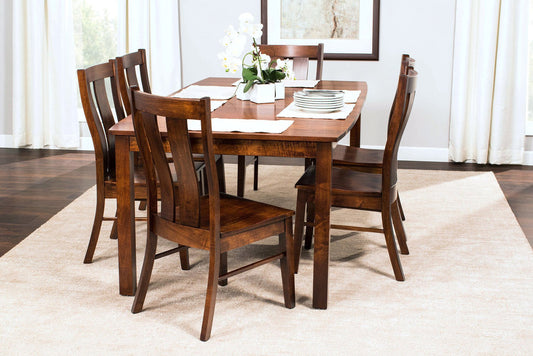How To Care for and Clean Leather Furniture in 5 Easy Steps
Leather is luxurious, durable, comfortable, breathable year-round and wears well over time. Because it’s also incredibly easy to care for, there’s no reason to let the purchase of leather furniture intimidate you!

Forgiving, low maintenance and easy to clean? Yes! Which is good news for anyone who might be concerned about the need to declare it off-limits to anything - food, drinks, kids, or your messy brother-in-law - that might leave behind remnants of their presence. Leather furniture is meant to be lived in and enjoyed as a sound investment that lasts a lifetime. And if you didn’t already know, aging only makes it that much more beautiful!
Here are five easy steps on how to care for and clean leather furniture with confidence.
1. Know what type of leather you have
This is important so that you can care for it properly. Generally, there are four distinct types:
A: Pure Aniline
- Little to no protective coating
- Shows natural markings and character of the hide
- Varies in shade and texture across panels
- Meant to age/patina
- Absorbs body and hair oils, some food spills
O: “Pull-Up” Leather
- Leather is pulled/stretched to create a burst of color
- Little to no protective coating
- Shows natural markings and character of the hide
- Meant to age/patina
- Absorbs body and hair oils, some food spills
P: Protected Leather
- Coated leather with variations in shade and texture
- Protected from most food and liquid spills
N: Nu-buck
- Pure aniline leather, abraded to create a suede-like nap with a soft feel
- Little to no protective coating
- Shows natural markings and character of the hide
- Meant to age/patina
- Absorbs body and hair oils, some food spills
At Modern Bungalow, our partnership with Omnia guarantees that only top grain leather is used. There are no splits, bonded leather or pleather and our customers have access to over 400 different variations (color, texture, treatments) of leather.
2. Test leather before cleaning
If you’re not sure what type of leather your furniture is made of, use your fingernail in a hidden area to lightly scratch the surface. If it leaves a mark, it’s not protected and you will want to hire a leather cleaning expert or find a cleaner specific to your type of leather. Keep in mind that after market products can void the warranty, so be sure to double-check.
Before using any type of cleaner or cleaning method, test for colorfastness. Do this by applying a small amount to a hidden area and then wait for it to completely dry. The leather will darken once the cleaner has been applied but should return to its same color once dry.
3. Clean leather furniture regularly
Just like we recommend with upholstered furniture, don’t forget to also dust and vacuum your leather. Dust clings as easily to smooth, leather surfaces as it does to upholstery and should be cleaned about once a week.
Use a leather conditioner to prevent cracking every 6-12 months dependent upon the climate you live in and after cleaning a spill or stain. Leather is a lot like skin that changes over time. Both require regular care to look their best!
4. General leather care and cleaning
The best way to care for and clean your leather furniture is to do it gently. Dusting can be done with a microfiber cloth that is barely damp. Rub in circular motions to loosen any dirt. When vacuuming, use the brush attachment on cushions and the crevice attachment for corners and between cushions.
If you notice your leather has slight scratches on its surface, you can use a chamois cloth to gently buff out the scratch. Apply a small amount of distilled water to the cloth for added benefit.
Anytime water is used on leather, be sure to let it air dry completely if you live in a drier climate or use a clean, dry towel to remove excess moisture and the potential for mildew in a more humid climate. The less water that is used, the better. Follow up any sort of cleaning with a leather conditioner.
Finally, avoid long periods of direct exposure to sunlight or heat as it will dry out the leather. If your leather furniture is next to a large window, close the curtains periodically to give it a break and keep up with regular conditioning.
5. What to do about spills and stains
From mild to severe, your best line of defense against stains is to address them as quickly as possible with the appropriate treatment. Stay away from Armor All, saddle soaps, and ammonia-based solutions.
Water-based
- Unprotected leather - blot off liquid and allow to air dry, contact professional cleaner before doing anything else if stain persists
-
Protected leather - Use clean cloth dampened in distilled water
- If stain is stubborn, mix mild non-detergent soap in lukewarm water and apply gently with a cloth. Blot dry with another soft cloth.
- Never use a hair dryer
Butter, Oil and Grease
- Blot off liquid but do not scrub or rub
- Oils will absorb into the hide over time
- Allow to air dry
Wax or gum
- Professional leather cleaning is recommended
- Do not try to scrape the spill as it will likely damage the leather
Ink
- Professional leather cleaning is recommended
Love your leather
Who knew that something so luxurious could be this low maintenance? By doing a few simple things, you’ll elongate the life of your leather furniture as you enjoy its enveloping sense of comfort year after year.
















